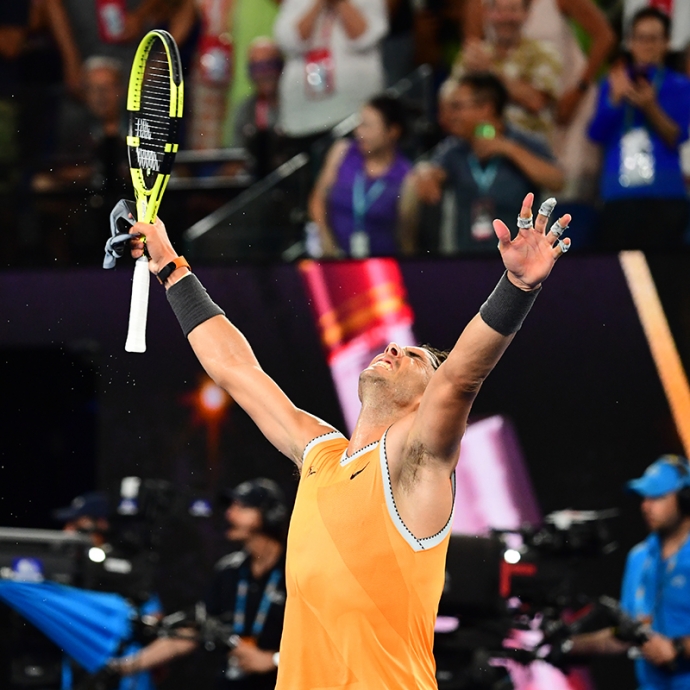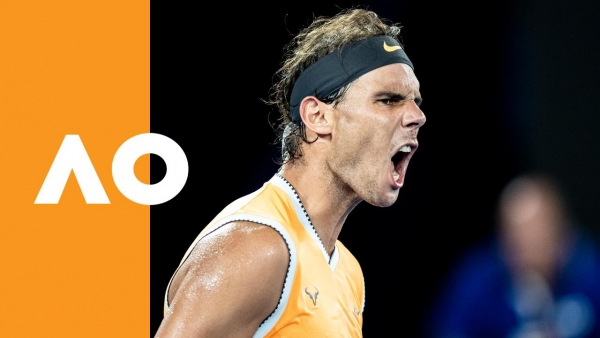The most epic rivalry of a glorious era deserves only the grandest setting. Novak Djokovic and Rafael Nadal have created that stage for their second Australian Open final.
And it’s not just that the world’s top two players are meeting in another Grand Slam decider that makes their 53rd career encounter so special.
Djokovic is competing for an all-time record seventh Australian Open title, adding to the magical history he’s established in Melbourne after winning the first of 14 majors titles here at age 20. Currently, the world No.1 sits atop the leaderboard alongside six-time champions Roy Emerson and Roger Federer.
For the second-ranked Nadal, there’s the opportunity to become the first man in the Open era – and only the third man in history – to win every major on at least two occasions. Should he add to his Australian Open 2009 title, the star Spaniard would join elite company in Emerson and Rod Laver.
“There's so much at stake, it's hard to pick one thing,” said Djokovic. “Obviously making history of the sport that I love is an honour and is a privilege. It's a huge motivation.”
Alongside those high stakes, there’s a near certainty of a match of the highest quality.
No two players in the Open era have competed more often than these combatants. From their first meeting at Roland Garros in 2006, they’ve built a compelling rivalry in which Nadal and Djokovic not only bring out each other’s best, but repeatedly elevate that standard to astonishing levels.
It was never better demonstrated than in the Australian Open 2012 final, when the fiercely contested battle spanned five hours and 53 minutes – the longest Grand Slam final in Open era history – before Djokovic finally secured a 5-7 6-4 6-2 6-7(5) 7-5 victory.
MORE: Djokovic jumps into seventh AO decider
More recently, there was a compelling five-set contest in the 2018 Wimbledon semifinals. Their14th meeting at a Grand Slam once again extended beyond the five-hour mark, the fighting spirit of each man evident in the 10-8 fifth set score that eventually favoured Djokovic.
“Those kinds of encounters have also made me the player I am today, without a doubt,” Djokovic said of their rivalry. “These are the kind of matches that you live for, finals of slams, playing the greatest rivals at their best. What more can you ask for? This is where you want to be.”
Nadal is equally excited for the challenge.
“We push each other to the limit of our tennis level,” said the Spaniard on Saturday. “Tomorrow going to be another episode.”
That fans can expect another edge-of-their seat encounter is evident in the devastating form they’ve each showed this year in Melbourne.
Djokovic’s journey to a seventh Australian Open final (and his 24th at a major) entailed a straightforward second-round victory over Jo-Wilfried Tsonga, whom he defeated for the 2008 title, and four-set wins over Denis Shapovalov and Daniil Medvedev in the third and fourth rounds respectively.
Nadal’s path is arguably even more impressive, the 2009 champion progressed to the 25th Grand Slam final of his career without a single set surrendered.
Most pertinent is the powerful message that Djokovic and Nadal have sent to the next generation.
The changing of the guard that seemed imminent as Lucas Pouille and Stefanos Tsitsipas progressed to maiden Grand Slam semifinals was quickly halted as the established champions dominated their opponents.
MORE: Rafa brings Tsitsipas story to abrupt end
Djokovic allowed Pouille just four games, taking 83 minutes to eliminate the Frenchman. Nadal was only slightly more forgiving, his 6-2 6-4 6-0 win over Tsitsipas secured in 106 minutes.
Such devastating form follows undeniable setbacks for each player. With injury a factor, Djokovic lost in the second round to 117th-ranked Denis Istomin at AO2017; last year No.58 Hyeon Chung upset the Serb in the fourth round.
Nadal has progressed to three more Australian Open finals since his 2009 victory but left each year without the trophy; the 2012 loss to Djokovic was followed by one to Stan Wawrinka in 2014; in 2017, he was eliminated by Roger Federer in a popular throwback final. Last year, the injured Spaniard was forced to retire in the quarterfinals against Marin Cilic.
It makes this final – their eighth at a Grand Slam – all the more significant. It is the first Open era-meeting between the top two seeds in a major final since the 2016 French Open, and only the 11th time it has occurred at the Australian Open.
If there’s an edge, it’s in the statistics, Djokovic holding a 27-25 head-to-head advantage. There’s also the fact that the last match that Nadal won on a hard court was at the 2013 US Open.
But for all the epic numbers that already exist in this rivalry, it’s the future ones that matter. Djokovic targets the 15th Grand Slam that would give him sole ownership of third position in the Grand Slam title leader list, where he currently sits alongside Pete Sampras. Nadal is bidding for an 18th major title, which would close the gap on Federer, whose 20 titles make him the most prolific men’s champion in history.
“We can promise one thing, and that’s knowing both of us that we’re going to give everything out on the court,” said Djokovic.
That’s in fact the only certainty in another tantalising encounter between the world’s top two players. Come the time to present the Norman Brookes Memorial Cup on Sunday, the reinstated champion will have worked hard to take his proud place in tennis history.


